Advancements in Lightweight Artificial Aggregates: Typologies, Compositions, Applications, and Prospects for the Future
Abstract
1. Introduction
2. Types of Artificial Lightweight Aggregates
2.1. Expanded Clay Aggregates
2.2. Expanded Shale Aggregates
2.3. Expanded Glass Aggregates
2.3.1. Glass Cullet Preparation
2.3.2. Controlled Heating for Expansion
2.4. Other Types of Lightweight Aggregates
2.4.1. Expanded Slag Aggregates
2.4.2. Sintered Fly Ash Aggregates
2.4.3. Vermiculite and Perlite Aggregates
2.4.4. Foamed Glass Aggregates
2.5. Plastic-Based Green Lightweight Aggregates
3. Properties of Artificial Lightweight Aggregates
3.1. Density
3.2. Thermal Conductivity
3.3. Mechanical Strength
4. Applications of Artificial Lightweight Aggregates
4.1. Construction Industry
4.1.1. High-Rise Buildings
4.1.2. Precast Elements
4.1.3. Infrastructure Development
4.1.4. Road Embankments
4.1.5. Lightweight Fill Materials
4.2. Geotechnical Engineering
4.2.1. Slope Stabilization
4.2.2. Land Reclamation
4.3. Horticulture and Landscaping
4.3.1. Horticulture and Soil Conditioning
4.3.2. Hydroponic Systems
4.3.3. Lightweight Garden Structures
5. Advantages and Challenges
6. Environmental Considerations and Sustainability Aspects
- Resource Extraction: The extraction and processing of raw materials for ALWAs can have environmental impacts, including habitat destruction, land degradation, and resource depletion. Sustainable sourcing practices and responsible mining techniques are essential to minimize environmental harm and preserve natural ecosystems [78].
- Energy Consumption: Lightweight aggregate production processes, such as firing and curing, may require significant energy inputs, contributing to greenhouse gas emissions and climate change. Adopting energy-efficient technologies, utilizing renewable energy sources, and optimizing production processes can reduce energy consumption and mitigate environmental impact [73].
- Waste Generation: Lightweight aggregate production produces waste that must be properly disposed of or recycled to reduce environmental effects. Recycling industrial by-products and using recycled materials in lightweight aggregate manufacturing can reduce waste and conserve resources [89].
7. Future Trends and Innovations
7.1. Ongoing Research and Development
7.2. Potential Advancements and Emerging Technologies
Future Applications
8. Role in Sustainable Development
8.1. Comparisons with Natural Aggregates and Artificial Aggregates
8.2. Specific Scenarios and Advantages
8.2.1. High-Rise Construction
8.2.2. Sustainable Building Practices
9. Case Study on Manufacturing of ALWAs
10. Conclusions
Author Contributions
Funding
Informed Consent Statement
Data Availability Statement
Conflicts of Interest
References
- de Andrade Salgado, F.; de Andrade Silva, F. Recycled aggregates from construction and demolition waste towards an application on structural concrete: A review. J. Build. Eng. 2022, 52, 104452. [Google Scholar] [CrossRef]
- Pessoa, S.; Guimarães, A.; Lucas, S.; Simões, N. 3D printing in the construction industry—A systematic review of the thermal performance in buildings. Renew. Sustain. Energy Rev. 2021, 141, 110794. [Google Scholar] [CrossRef]
- Raza, J.; Farina, I.; Colangelo, F.; Singh, N. Properties of concrete containing polyethylene terephthalate and artificial lightweight aggregates: A case study. In Reuse of Plastic Waste in Eco-Efficient Concrete; Elsevier: Amsterdam, The Netherlands, 2024; pp. 85–112. [Google Scholar]
- Raza, J.; Singh, N.; Colangelo, F.; Farina, I. Sustainability Assessment of Lightweight Artificial Aggregates Made from Industrial Waste Using a Double-Step Cold Bonding Palletization Process. Adv. Sci. Technol. 2024, 149, 15–19. [Google Scholar]
- Han, B.; Zhang, L.; Ou, J. Smart and Multifunctional Concrete Toward Sustainable Infrastructures; Springer Nature: Dordrecht, The Netherlands, 2017. [Google Scholar]
- Sahoo, S.; Selvaraju, A.K.; Prakash, S.S. Mechanical characterization of structural lightweight aggregate concrete made with sintered fly ash aggregates and synthetic fibres. Cem. Concr. Compos. 2020, 113, 103712. [Google Scholar] [CrossRef]
- Sarabèr, A.; Overhof, R.; Green, T.; Pels, J. Artificial lightweight aggregates as utilization for future ashes—A case study. Waste Manag. 2012, 32, 144–152. [Google Scholar] [CrossRef]
- Singh, N.; Colangelo, F.; Farina, I. Sustainable Non-Conventional Concrete 3D Printing—A Review. Sustainability 2023, 15, 10121. [Google Scholar] [CrossRef]
- Jayadurgalakshmi, M.; Suganya, N.; Kumar, T.U. A state-of-the-art review—Mechanical properties of light weight concrete by utilizing sintered fly ash aggregate. Mater. Today Proc. 2023, in press. [CrossRef]
- Behera, M.; Bhattacharyya, S.; Minocha, A.; Deoliya, R.; Maiti, S. Recycled aggregate from C&D waste & its use in concrete—A breakthrough towards sustainability in construction sector: A review. Constr. Build. Mater. 2014, 68, 501–516. [Google Scholar] [CrossRef]
- Li, Z.; Liu, L.; Yan, S.; Zhang, M.; Xia, J.; Xie, Y. Effect of freeze-thaw cycles on mechanical and porosity properties of recycled construction waste mixtures. Constr. Build. Mater. 2019, 210, 347–363. [Google Scholar] [CrossRef]
- Adhikary, S.K.; Ashish, D.K. Turning waste expanded polystyrene into lightweight aggregate: Towards sustainable construction industry. Sci. Total. Environ. 2022, 837, 155852. [Google Scholar] [CrossRef]
- Rashad, A.M. Lightweight expanded clay aggregate as a building material—An overview. Constr. Build. Mater. 2018, 170, 757–775. [Google Scholar] [CrossRef]
- Zhao, M.; Zhao, M.; Chen, M.; Li, J.; Law, D. An experimental study on strength and toughness of steel fiber reinforced expanded-shale lightweight concrete. Constr. Build. Mater. 2018, 183, 493–501. [Google Scholar] [CrossRef]
- Nunes, V.A.; Borges, P.H. Recent advances in the reuse of steel slags and future perspectives as binder and aggregate for alkali-activated materials. Constr. Build. Mater. 2021, 281, 122605. [Google Scholar] [CrossRef]
- Vakhshouri, B.; Nejadi, S. Review on the mixture design and mechanical properties of the lightweight concrete containing expanded polystyrene beads. Aust. J. Struct. Eng. 2017, 19, 1–23. [Google Scholar] [CrossRef]
- Vijayalakshmi, R.; Ramanagopal, S. Structural concrete using expanded clay aggregate: A review. Indian J. Sci. Technol. 2018, 11, 1–12. [Google Scholar] [CrossRef]
- Kilinç, K.; Karasu, B.; Kaya, G.; Kivrak, S. A preliminary research on the properties of lightweight expanded clay aggregate. J. Aust. Ceram. Soc 2008, 44, 23–30. [Google Scholar]
- Özkılıç’, Y.O.; Beskopylny, A.N.; Stel’makh, S.A.; Shcherban’, E.M.; Mailyan, L.R.; Meskhi, B.; Chernil’nik, A.; Ananova, O.; Aksoylu, C.; Madenci, E. Lightweight expanded-clay fiber concrete with improved characteristics reinforced with short natural fibers. Case Stud. Constr. Mater. 2023, 19, e02367. [Google Scholar] [CrossRef]
- Lotfy, A.; Hossain, K.M.A.; Lachemi, M. Lightweight self-consolidating concrete with expanded shale aggregates: Modelling and optimization. Int. J. Concr. Struct. Mater. 2015, 9, 185–206. [Google Scholar] [CrossRef]
- Ghorbani, Y.; Nwaila, G.T.; Zhang, S.E.; Bourdeau, J.E.; Cánovas, M.; Arzua, J.; Nikadat, N. Moving towards deep underground mineral resources: Drivers, challenges and potential solutions. Resour. Policy 2023, 80, 103222. [Google Scholar] [CrossRef]
- Zaid, O.; Alsharari, F.; Althoey, F.; Elhag, A.B.; Hadidi, H.M.; Abuhussain, M.A. Assessing the performance of palm oil fuel ash and Lytag on the development of ultra-high-performance self-compacting lightweight concrete with waste tire steel fibers. J. Build. Eng. 2023, 76, 107112. [Google Scholar] [CrossRef]
- Adhikary, S.K.; Ashish, D.K.; Rudžionis, Ž. Expanded glass as light-weight aggregate in concrete—A review. J. Clean. Prod. 2021, 313, 127848. [Google Scholar] [CrossRef]
- Brand, A.S.; Roesler, J.R. Steel furnace slag aggregate expansion and hardened concrete properties. Cem. Concr. Compos. 2015, 60, 1–9. [Google Scholar] [CrossRef]
- Jiang, J.; Lei, L.; Jin, C.; Liu, T.; Huang, J.; Wu, Y.; Lv, S.; Lu, Z.; Zheng, L.; Li, J. Preparation, microstructure, performance and mortar application of paraffin/titanium-bearing blast furnace slag phase change aggregate. Case Stud. Constr. Mater. 2023, 19, e02262. [Google Scholar] [CrossRef]
- Cai, Y.; Song, N.; Yang, Y.; Sun, L.; Hu, P.; Wang, J. Recent progress of efficient utilization of titanium-bearing blast furnace slag. Int. J. Miner. Met. Mater. 2022, 29, 22–31. [Google Scholar] [CrossRef]
- Mao, N.; Jin, C.; Gao, Y.; Jiang, J.; Liu, T.; Wu, Y.; Huang, J.; Lu, Z.; Wen, J.; Wen, J.; et al. Expanded titanium-bearing blast furnace slag phase change aggregate: Preparation, performance and phase change energy storage mortar application. J. Build. Eng. 2024, 83, 108306. [Google Scholar] [CrossRef]
- Ramamurthy, K.; Harikrishnan, K. Influence of binders on properties of sintered fly ash aggregate. Cem. Concr. Compos. 2006, 28, 33–38. [Google Scholar] [CrossRef]
- Nadesan, M.S.; Dinakar, P. Structural concrete using sintered flyash lightweight aggregate: A review. Constr. Build. Mater. 2017, 154, 928–944. [Google Scholar] [CrossRef]
- Chen, H.-J.; Wang, S.-Y.; Tang, C.-W. Reuse of incineration fly ashes and reaction ashes for manufacturing lightweight aggregate. Constr. Build. Mater. 2010, 24, 46–55. [Google Scholar] [CrossRef]
- Korniejenko, K.; Pławecka, K.; Bulut, A.; Şahin, B.; Azizağaoğlu, G.; Figiela, B. Development of lightweight geopolymer composites containing perlite and vermiculite. J. Achiev. Mater. Manuf. Eng. 2023, 117, 49–56. [Google Scholar] [CrossRef]
- Singh, M.; Garg, M. Perlite-based building materials—A review of current applications. Constr. Build. Mater. 1991, 5, 75–81. [Google Scholar] [CrossRef]
- Tie, T.S.; Mo, K.H.; Alengaram, U.J.; Kaliyavaradhan, S.K.; Ling, T.-C. Study on the use of lightweight expanded perlite and vermiculite aggregates in blended cement mortars. Eur. J. Environ. Civ. Eng. 2022, 26, 3612–3631. [Google Scholar] [CrossRef]
- Terzic, A.; Stojanovic, J.; Andric, L.; Milicic, L.; Radojevic, Z. Performances of vermiculite and perlite based thermal insulation lightweight concretes. Sci. Sinter. 2020, 52, 149–162. [Google Scholar] [CrossRef]
- Sharma, L.; Taak, N.; Bhandari, M. Influence of ultra-lightweight foamed glass aggregate on the strength aspects of lightweight concrete. Mater. Today Proc. 2021, 45, 3240–3246. [Google Scholar] [CrossRef]
- Limbachiya, M.; Meddah, M.S.; Fotiadou, S. Performance of granulated foam glass concrete. Constr. Build. Mater. 2012, 28, 759–768. [Google Scholar] [CrossRef]
- Amran, M.; Fediuk, R.; Vatin, N.; Lee, Y.H.; Murali, G.; Ozbakkaloglu, T.; Klyuev, S.; Alabduljabber, H. Fibre-reinforced foamed concretes: A review. Materials 2020, 13, 4323. [Google Scholar] [CrossRef]
- Amran, Y.M.; Farzadnia, N.; Ali, A.A. Properties and applications of foamed concrete; a review. Constr. Build. Mater. 2015, 101, 990–1005. [Google Scholar] [CrossRef]
- Abu-Jdayil, B.; Mourad, A.-H.; Hittini, W.; Hassan, M.; Hameedi, S. Traditional, state-of-the-art and renewable thermal building insulation materials: An overview. Constr. Build. Mater. 2019, 214, 709–735. [Google Scholar] [CrossRef]
- Hanif, A.; Lu, Z.; Li, Z. Utilization of fly ash cenosphere as lightweight filler in cement-based composites—A review. Constr. Build. Mater. 2017, 144, 373–384. [Google Scholar] [CrossRef]
- Sahu, K.M.; Patra, S.; Swain, S.K. Viability of Building Materials Made of Wood Waste: Sustainability and Its Performances. In Wood Waste Management and Products; Springer: Berlin/Heidelberg, Germany, 2023; pp. 93–110. [Google Scholar]
- Alqahtani, F.K. Sustainable green lightweight concrete containing plastic-based green lightweight aggregate. Materials 2021, 14, 3304. [Google Scholar] [CrossRef]
- Jubinville, D.; Esmizadeh, E.; Saikrishnan, S.; Tzoganakis, C.; Mekonnen, T. A comprehensive review of global production and recycling methods of polyolefin (PO) based products and their post-recycling applications. Sustain. Mater. Technol. 2020, 25, e00188. [Google Scholar] [CrossRef]
- Zulkernain, N.H.; Gani, P.; Chuan, N.C.; Uvarajan, T. Utilisation of plastic waste as aggregate in construction materials: A review. Constr. Build. Mater. 2021, 296, 123669. [Google Scholar] [CrossRef]
- Lizárraga-Mendiola, L.; López-León, L.D.; Vázquez-Rodríguez, G.A. municipal solid waste as a substitute for virgin materials in the construction industry: A review. Sustainability 2022, 14, 16343. [Google Scholar] [CrossRef]
- Paletta, A.; Filho, W.L.; Balogun, A.-L.; Foschi, E.; Bonoli, A. Barriers and challenges to plastics valorisation in the context of a circular economy: Case studies from Italy. J. Clean. Prod. 2019, 241, 118149. [Google Scholar] [CrossRef]
- Alqahtani, F.K.; Zafar, I. Characterization of processed lightweight aggregate and its effect on physical properties of concrete. Constr. Build. Mater. 2020, 230, 116992. [Google Scholar] [CrossRef]
- Lu, J.-X. Recent advances in high strength lightweight concrete: From development strategies to practical applications. Constr. Build. Mater. 2023, 400, 132905. [Google Scholar] [CrossRef]
- Karakurt, C.; Özen, U. Influence of natural lightweight aggregates on the properties of concrete. J. Turk. Chem. Soc. Sect. B 2017, 1, 9–16. [Google Scholar]
- Fookes, P.G. An introduction to the influence of natural aggregates on the performance and durability of concrete. Q. J. Eng. Geol. 1980, 13, 207–229. [Google Scholar] [CrossRef]
- Demirboğa, R.; Gül, R. The effects of expanded perlite aggregate, silica fume and fly ash on the thermal conductivity of lightweight concrete. Cem. Concr. Res. 2003, 33, 723–727. [Google Scholar] [CrossRef]
- Sua-Iam, G.; Makul, N. Potential Future Direction of the Sustainable Production of Precast Concrete with Recycled Concrete Aggregate: A Critical Review. Eng. Sci. 2024, 28, 1075. [Google Scholar] [CrossRef]
- AlShareedah, O.; Nassiri, S. Pervious concrete mixture optimization, physical, and mechanical properties and pavement design: A review. J. Clean. Prod. 2021, 288, 125095. [Google Scholar] [CrossRef]
- Hou, Y.; Ji, X.; Su, X. Mechanical properties and strength criteria of cement-stabilised recycled concrete aggregate. Int. J. Pavement Eng. 2019, 20, 339–348. [Google Scholar] [CrossRef]
- Little, D.N. Evaluation of Structural Properties of Lime Stabilized Soils and Aggregates; National Lime Association: Arlington, VA, USA, 1998. [Google Scholar]
- Barbhuiya, S.; Kanavaris, F.; Das, B.B.; Idrees, M. Decarbonising cement and concrete production: Strategies, challenges and pathways for sustainable development. J. Build. Eng. 2024, 86, 108861. [Google Scholar] [CrossRef]
- Al-Kodmany, K. Sustainability and the 21st century vertical city: A review of design approaches of tall buildings. Buildings 2018, 8, 102. [Google Scholar] [CrossRef]
- Muda, Z.C.; Shafigh, P.; Mahyuddin, N.B.; Sepasgozar, S.M.; Beddu, S.; Zakaria, A. Energy performance of a high-rise residential building using fibre-reinforced structural lightweight aggregate concrete. Appl. Sci. 2020, 10, 4489. [Google Scholar] [CrossRef]
- Garg, T.; Anand, A.A. Analysis of Advance Structural Materials Usage in the Construction of High-Rise Building & Its Applicability in India. J. ReAttach Ther. Dev. Divers. 2023, 6, 1183–1214. [Google Scholar] [CrossRef]
- Kumar, J.D.C.; Arunakanthi, E. The use of lightweight aggregates for precast concrete structural members. Int. J. Appl. Eng. Res. 2018, 13, 7779–7787. [Google Scholar]
- Li, S.; Chen, W.; Zhang, Y. Flexural behavior of precast, prestressed, lightweight aggregate concrete-conventional concrete composite beams. Constr. Build. Mater. 2021, 274, 121926. [Google Scholar] [CrossRef]
- Robinson, G.P.; Austin, S.A.; Palmeri, A. Adoption of artificial lightweight aggregate in precast manufacture. Mag. Concr. Res. 2013, 65, 1173–1186. [Google Scholar] [CrossRef]
- Sarkar, K.; Shiuly, A.; Dhal, K.G. Revolutionizing concrete analysis: An in-depth survey of AI-powered insights with image-centric approaches on comprehensive quality control, advanced crack detection and concrete property exploration. Constr. Build. Mater. 2024, 411, 134212. [Google Scholar] [CrossRef]
- Hasan, A.M.; Shwan, B.J.; Aziz, O.Q. Soil-structure interaction of two different configurations of a cut and cover tunnel. In Geotechnical Engineering Challenges to Meet Current and Emerging Needs of Society; CRC Press: Boca Raton, FL, USA, 2024; pp. 528–531. [Google Scholar]
- Lodi, L. Development of a Sustainable Circular Economy System in the Roofing and Geo Composites Industries. Ph.D. Thesis, Politecnico di Torino, Turin, Italy, 2023. [Google Scholar]
- Marradi, A.; Pinori, U.; Betti, G. The use of lightweight materials in road embankment construction. Procedia—Soc. Behav. Sci. 2012, 53, 1000–1009. [Google Scholar] [CrossRef]
- Zhou, H.; Brooks, A.L. Thermal and mechanical properties of structural lightweight concrete containing lightweight aggregates and fly-ash cenospheres. Constr. Build. Mater. 2019, 198, 512–526. [Google Scholar] [CrossRef]
- Holm, T.; Valsangkar, A. Lightweight aggregate soil mechanics: Properties and applications. Transp. Res. Rec. 1993, 1422, 7. [Google Scholar]
- Herle, V.; Santini, A.; Moraci, N. Use of Reinforced Lightweight Clay Aggregates for Landslide Stabilisation. AIP Conf. Proc. 2008, 1020, 517–524. [Google Scholar]
- Liu, R.; Coffman, R. Lightweight aggregate made from dredged material in green roof construction for stormwater management. Materials 2016, 9, 611. [Google Scholar] [CrossRef]
- González-Corrochano, B.; Alonso-Azcárate, J.; Rodríguez, L.; Lorenzo, A.P.; Torío, M.F.; Ramos, J.J.T.; Corvinos, M.D.; Muro, C. Valorization of washing aggregate sludge and sewage sludge for lightweight aggregates production. Constr. Build. Mater. 2016, 116, 252–262. [Google Scholar] [CrossRef]
- Moreno-Maroto, J.M.; González-Corrochano, B.; Alonso-Azcárate, J.; Rodríguez, L.; Acosta, A. Development of lightweight aggregates from stone cutting sludge, plastic wastes and sepiolite rejections for agricultural and environmental purposes. J. Environ. Manag. 2017, 200, 229–242. [Google Scholar] [CrossRef]
- Cavalline, T.L.; Gallegos, J.; Castrodale, R.W.; Freeman, C.; Liner, J.; Wall, J. Influence of lightweight aggregate concrete materials on building energy performance. Buildings 2021, 11, 94. [Google Scholar] [CrossRef]
- Sifan, M.; Nagaratnam, B.; Thamboo, J.; Poologanathan, K.; Corradi, M. Development and prospectives of lightweight high strength concrete using lightweight aggregates. Constr. Build. Mater. 2023, 362, 129628. [Google Scholar] [CrossRef]
- Gür, T.M. Carbon dioxide emissions, capture, storage and utilization: Review of materials, processes and technologies. Prog. Energy Combust. Sci. 2022, 89, 100965. [Google Scholar] [CrossRef]
- Poon, C.S.; Chan, D. Feasible use of recycled concrete aggregates and crushed clay brick as unbound road sub-base. Constr. Build. Mater. 2006, 20, 578–585. [Google Scholar] [CrossRef]
- Siddique, R.; Kaur, D. Properties of concrete containing ground granulated blast furnace slag (GGBFS) at elevated temperatures. J. Adv. Res. 2012, 3, 45–51. [Google Scholar] [CrossRef]
- Chandra, S.; Berntsson, L. Lightweight Aggregate Concrete; Elsevier: Amsterdam, The Netherlands, 2002. [Google Scholar]
- Gronba-Chyła, A.; Generowicz, A.; Alwaeli, M.; Mannheim, V.; Grąz, K.; Kwaśnicki, P.; Kramek, A. Municipal waste utilization as a substitute for natural aggregate in the light of the circular economy. J. Clean. Prod. 2024, 440, 140907. [Google Scholar] [CrossRef]
- Sloan, J.J.; Ampim, P.A.Y.; Basta, N.T.; Scott, R. Addressing the need for soil blends and amendments for the highly modified urban landscape. Soil Sci. Soc. Am. J. 2012, 76, 1133–1141. [Google Scholar] [CrossRef]
- Mikulčić, H.; Klemeš, J.J.; Vujanović, M.; Urbaniec, K.; Duić, N. Reducing greenhouse gasses emissions by fostering the deployment of alternative raw materials and energy sources in the cleaner cement manufacturing process. J. Clean. Prod. 2016, 136, 119–132. [Google Scholar] [CrossRef]
- Sorvari, J. Developing environmental legislation to promote recycling of industrial by-products—An endless story? Waste Manag. 2008, 28, 489–501. [Google Scholar] [CrossRef]
- Real, S.; Gomes, M.G.; Rodrigues, A.M.; Bogas, J.A. Contribution of structural lightweight aggregate concrete to the reduction of thermal bridging effect in buildings. Constr. Build. Mater. 2016, 121, 460–470. [Google Scholar] [CrossRef]
- Braungart, M.; McDonough, W.; Bollinger, A. Cradle-to-cradle design: Creating healthy emissions–a strategy for eco-effective product and system design. J. Clean. Prod. 2007, 15, 1337–1348. [Google Scholar] [CrossRef]
- Petrillo, A.; Colangelo, F.; Farina, I.; Travaglioni, M.; Salzano, C.; Cioffi, R. Multi-criteria analysis for Life Cycle Assessment and Life Cycle Costing of lightweight artificial aggregates from industrial waste by double-step cold bonding palletization. J. Clean. Prod. 2022, 351, 131395. [Google Scholar] [CrossRef]
- Huang, L.; Yang, Z.; Li, Z.; Xu, Y.; Yu, L. Recycling of the end-of-life lightweight aggregate concrete (LWAC) with a novel approach. J. Clean. Prod. 2020, 275, 123099. [Google Scholar] [CrossRef]
- Cosgrove, W.J.; Loucks, D.P. Water management: Current and future challenges and research directions. Water Resour. Res. 2015, 51, 4823–4839. [Google Scholar] [CrossRef]
- Worlanyo, A.S.; Jiangfeng, L. Evaluating the environmental and economic impact of mining for post-mined land restoration and land-use: A review. J. Environ. Manag. 2021, 279, 111623. [Google Scholar] [CrossRef] [PubMed]
- Wang, J.; Zheng, K.; Cui, N.; Cheng, X.; Ren, K.; Hou, P.; Feng, L.; Zhou, Z.; Xie, N. Green and durable lightweight aggregate concrete: The role of waste and recycled materials. Materials 2020, 13, 3041. [Google Scholar] [CrossRef] [PubMed]
- Sabău, M.; Bompa, D.V.; Silva, L.F. Comparative carbon emission assessments of recycled and natural aggregate concrete: Environmental influence of cement content. Geosci. Front. 2021, 12, 101235. [Google Scholar] [CrossRef]
- Jiménez, L.F.; Domínguez, J.A.; Vega-Azamar, R.E. Carbon footprint of recycled aggregate concrete. Adv. Civ. Eng. 2018, 2018, 1–6. [Google Scholar] [CrossRef]
- Flower, D.J.; Sanjayan, J.G. Green house gas emissions due to concrete manufacture. Int. J. Life Cycle Assess. 2007, 12, 282–288. [Google Scholar] [CrossRef]
- Alqahtani, F.K.; Abotaleb, I.S.; Harb, S. LEED Study of green lightweight aggregates in construction. Sustainability 2021, 13, 1395. [Google Scholar] [CrossRef]
- Roth, F.; Broman, E.; Sun, X.; Bonaglia, S.; Nascimento, F.; Prytherch, J.; Brüchert, V.; Zara, M.L.; Brunberg, M.; Geibel, M.C.; et al. Methane emissions offset atmospheric carbon dioxide uptake in coastal macroalgae, mixed vegetation and sediment ecosystems. Nat. Commun. 2023, 14, 42. [Google Scholar] [CrossRef]
- Ren, P.; Ling, T.-C.; Mo, K.H. Recent advances in artificial aggregate production. J. Clean. Prod. 2021, 291, 125215. [Google Scholar] [CrossRef]
- Akeed, M.H.; Qaidi, S.; Ahmed, H.U.; Faraj, R.H.; Mohammed, A.S.; Emad, W.; Tayeh, B.A.; Azevedo, A.R. Ultra-high-performance fiber-reinforced concrete. Part IV: Durability properties, cost assessment, applications, and challenges. Case Stud. Constr. Mater. 2022, 17, e01271. [Google Scholar] [CrossRef]
- Shang, X.; Chang, J.; Yang, J.; Ke, X.; Duan, Z. Life cycle sustainable assessment of natural vs artificial lightweight aggregates. J. Clean. Prod. 2022, 367, 133064. [Google Scholar] [CrossRef]
- Tajra, F.; Elrahman, M.A.; Stephan, D. The production and properties of cold-bonded aggregate and its applications in concrete: A review. Constr. Build. Mater. 2019, 225, 29–43. [Google Scholar] [CrossRef]
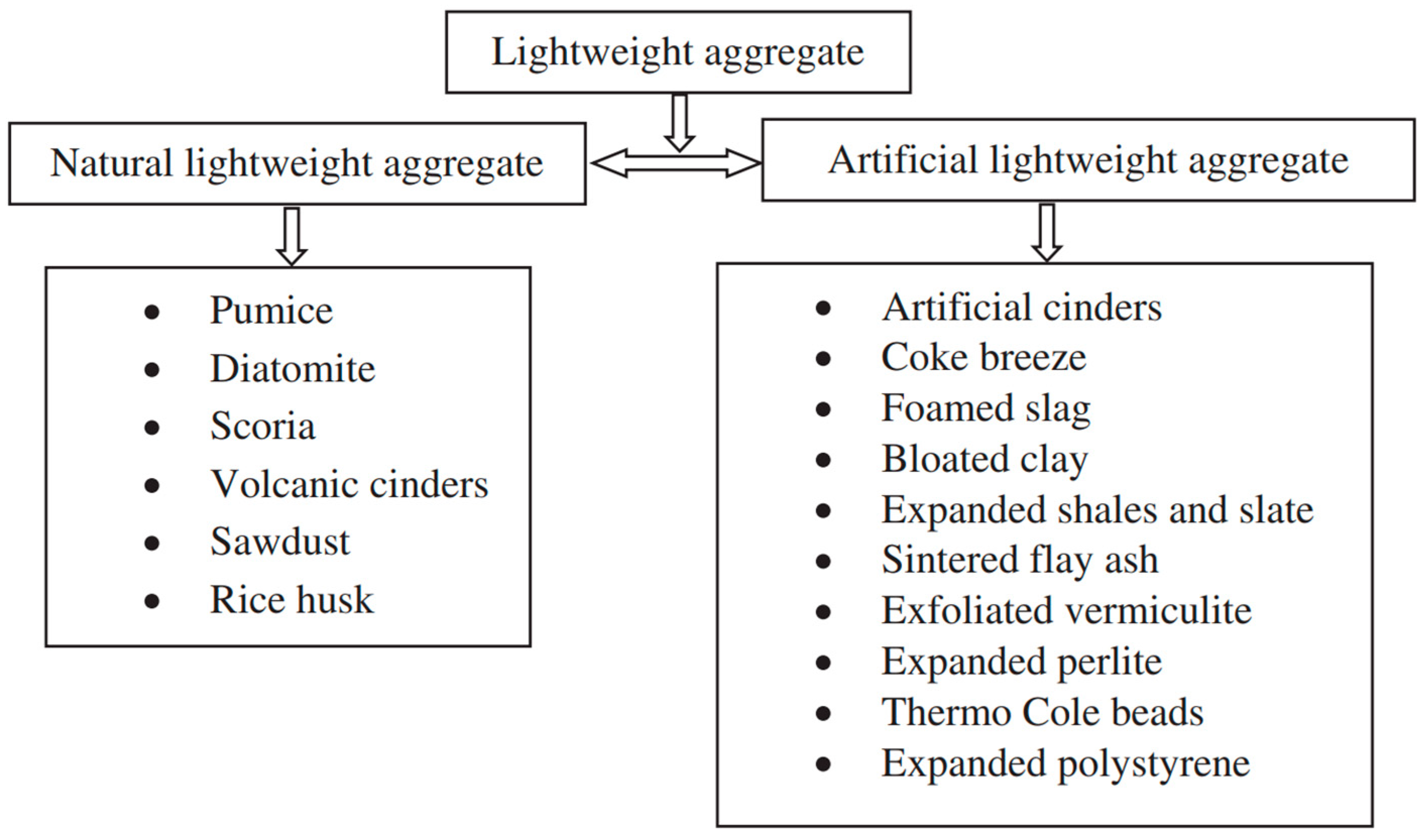


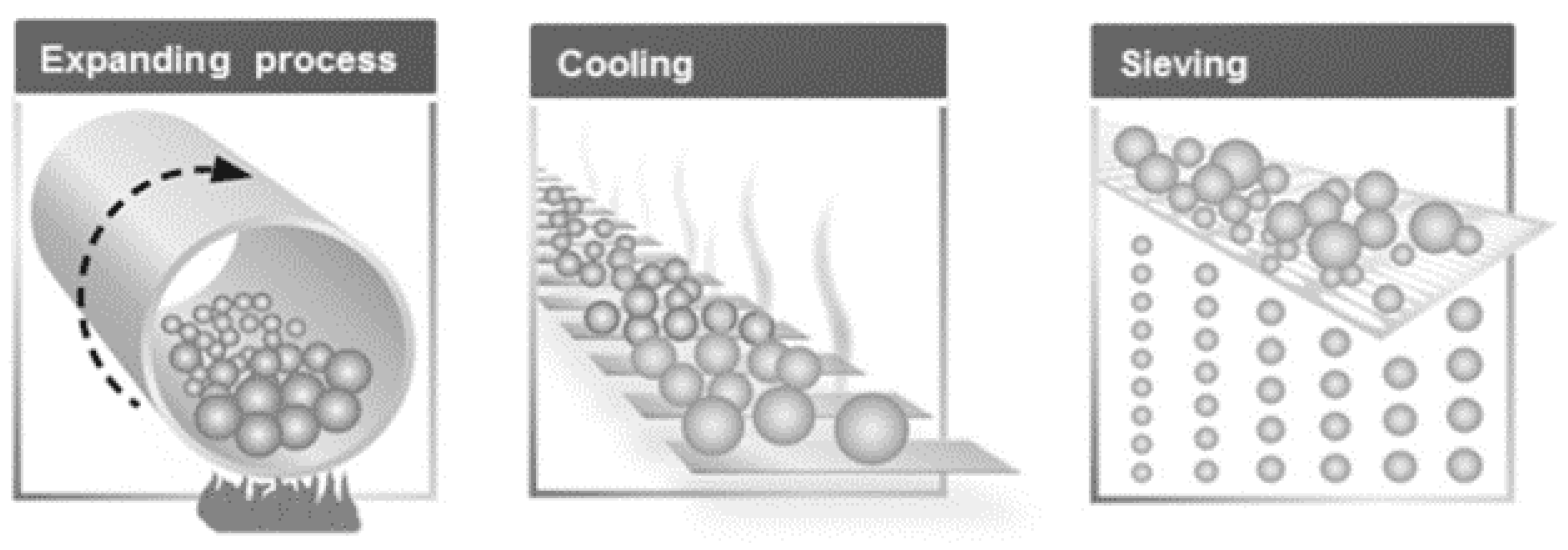

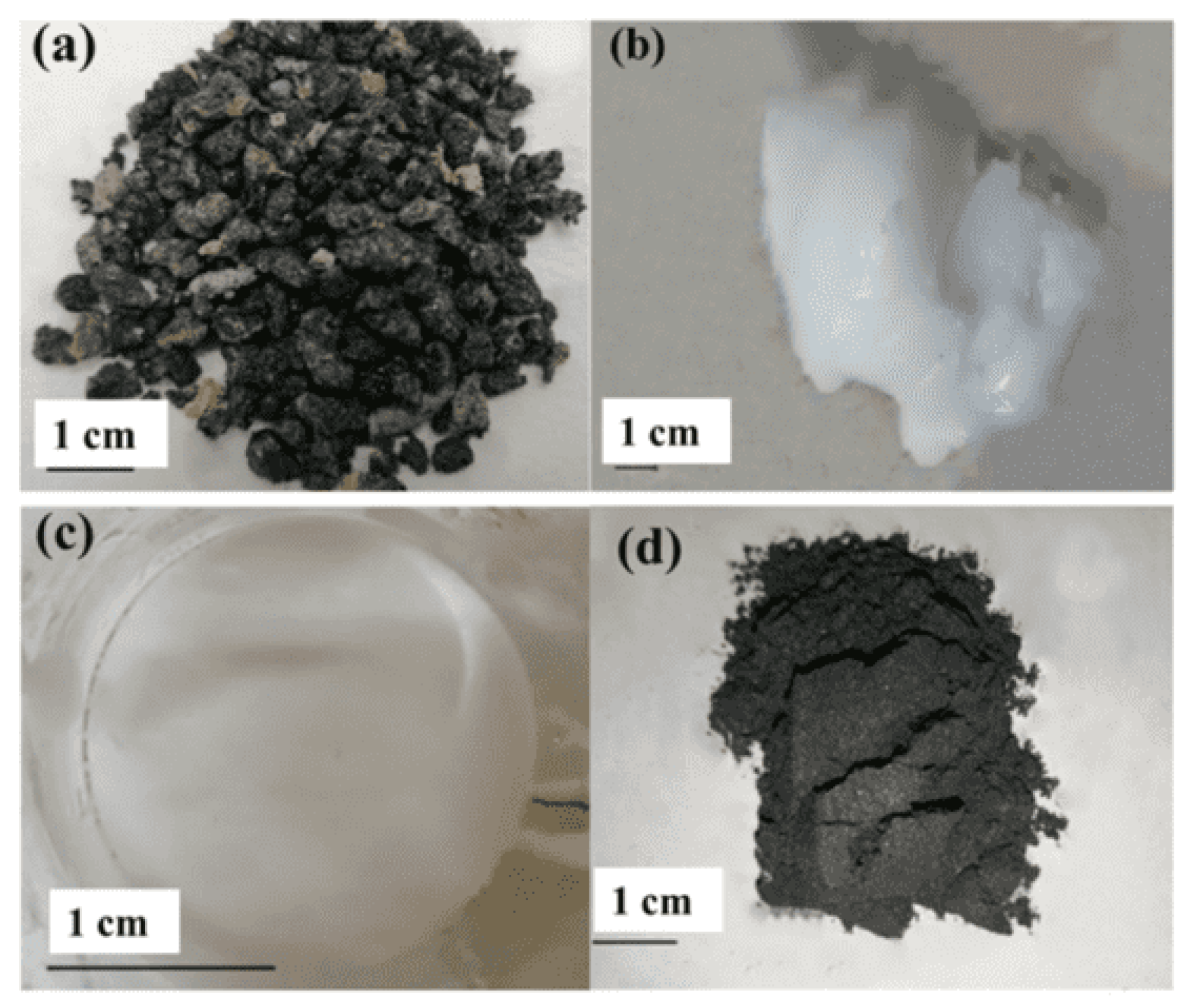

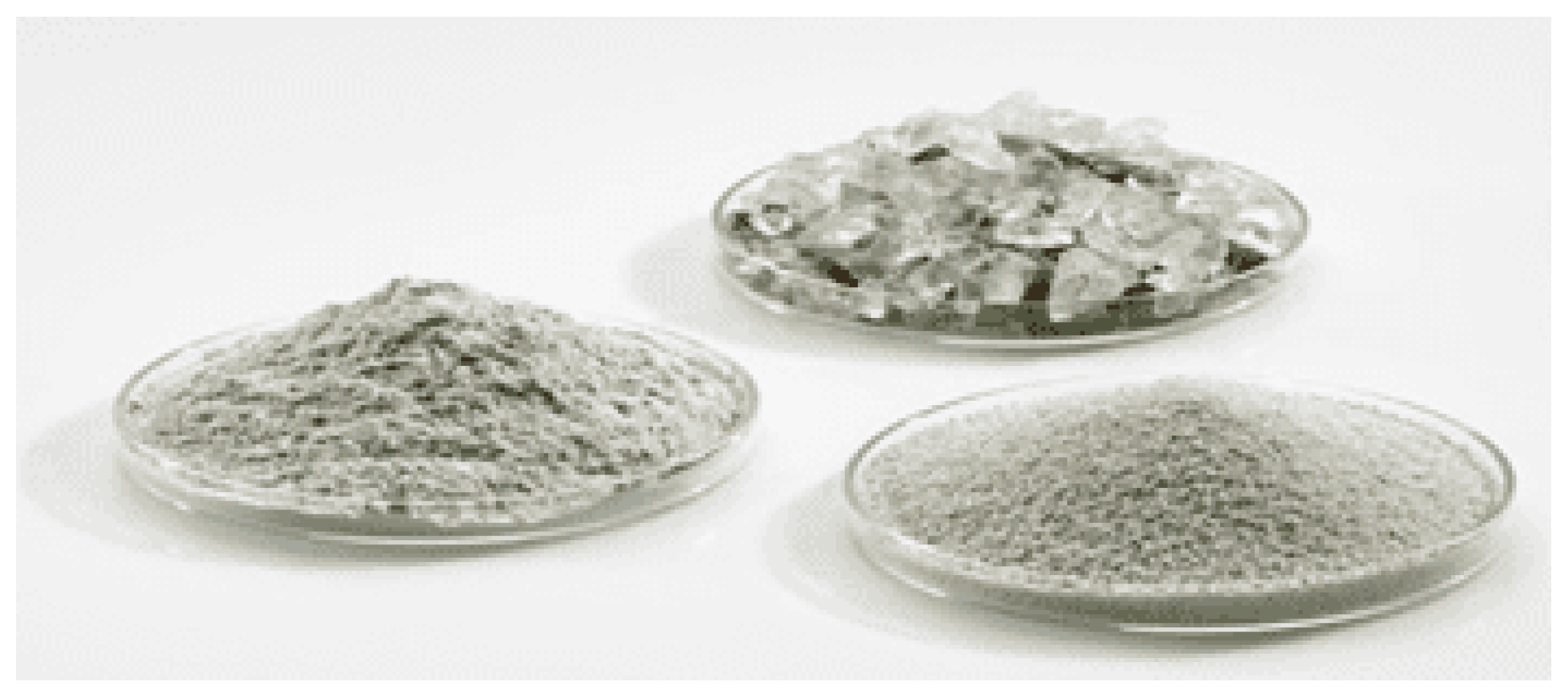
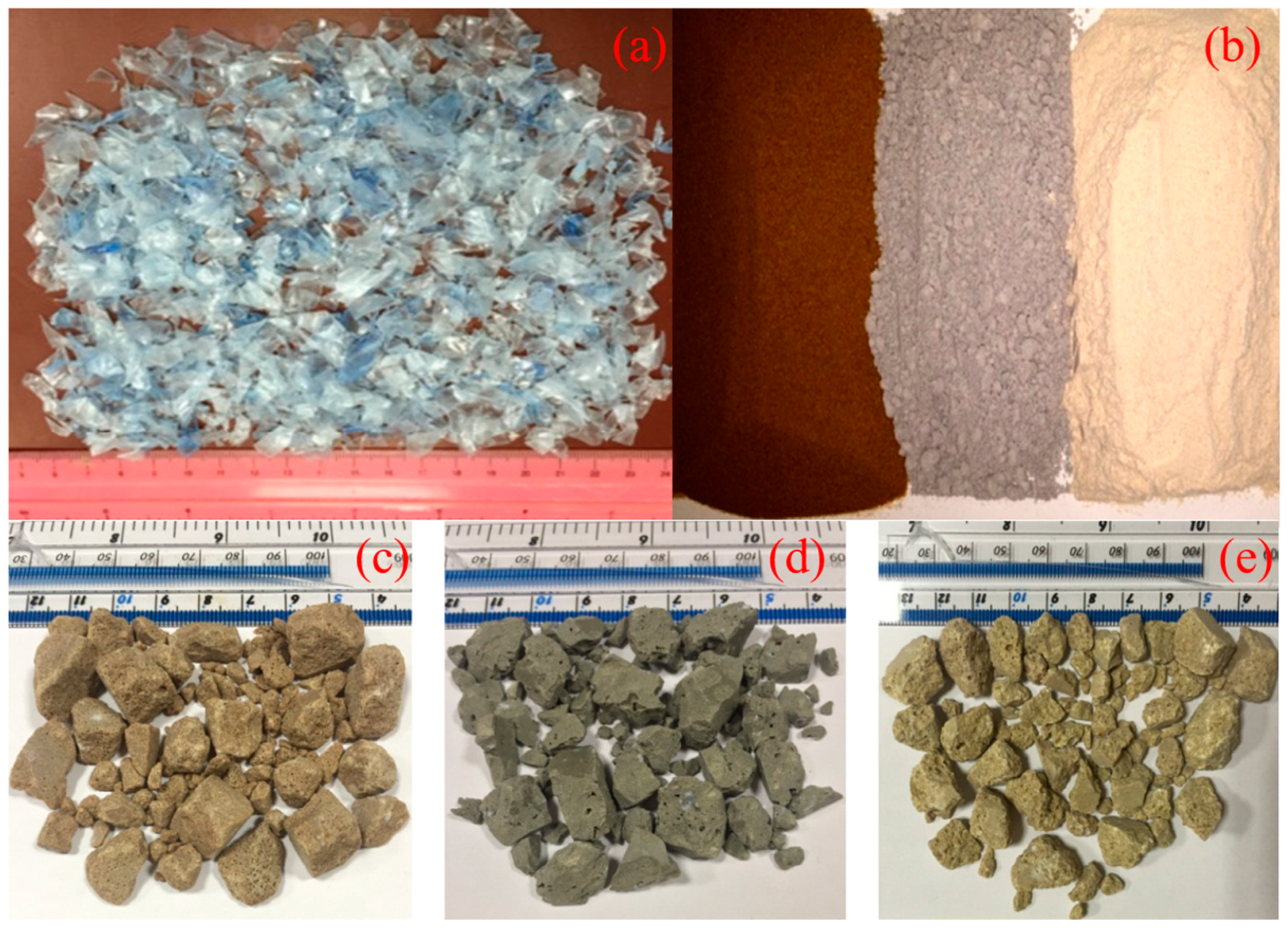

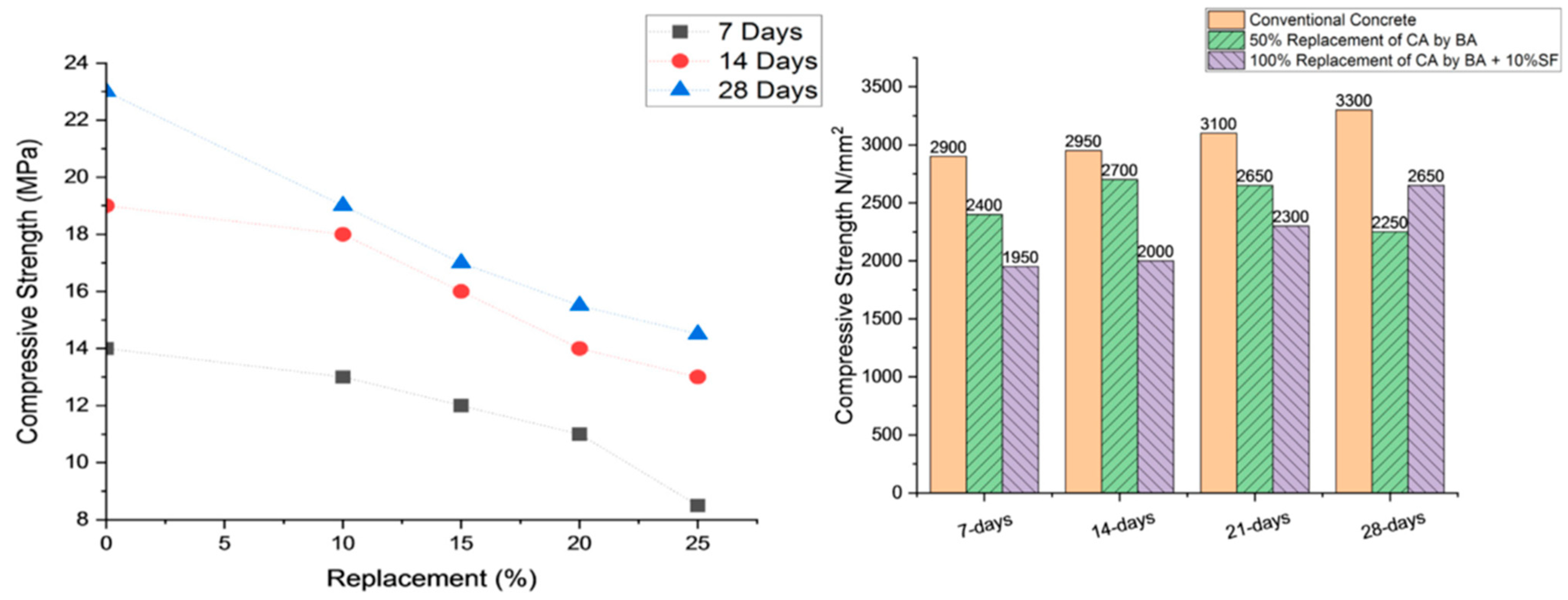
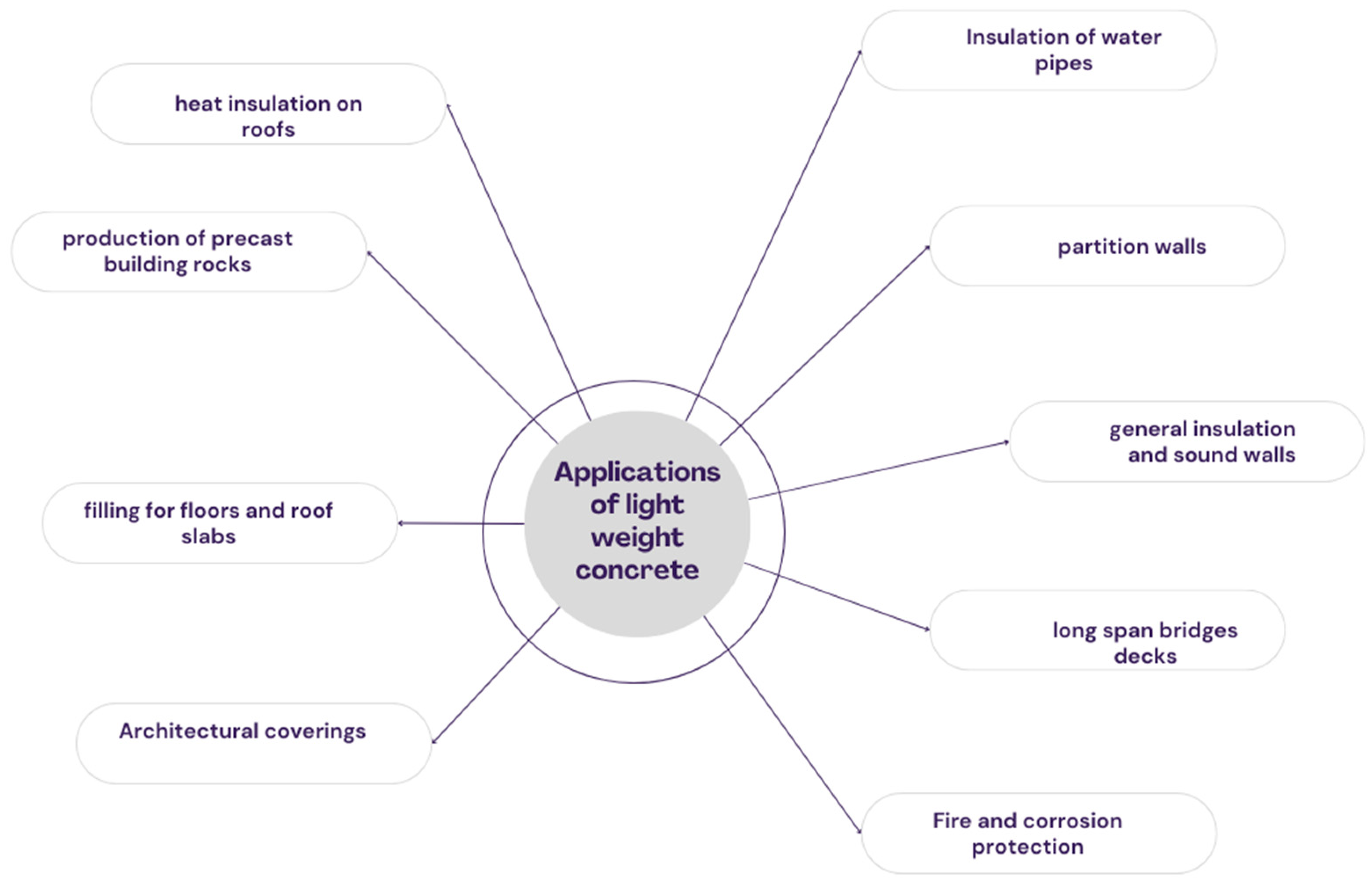
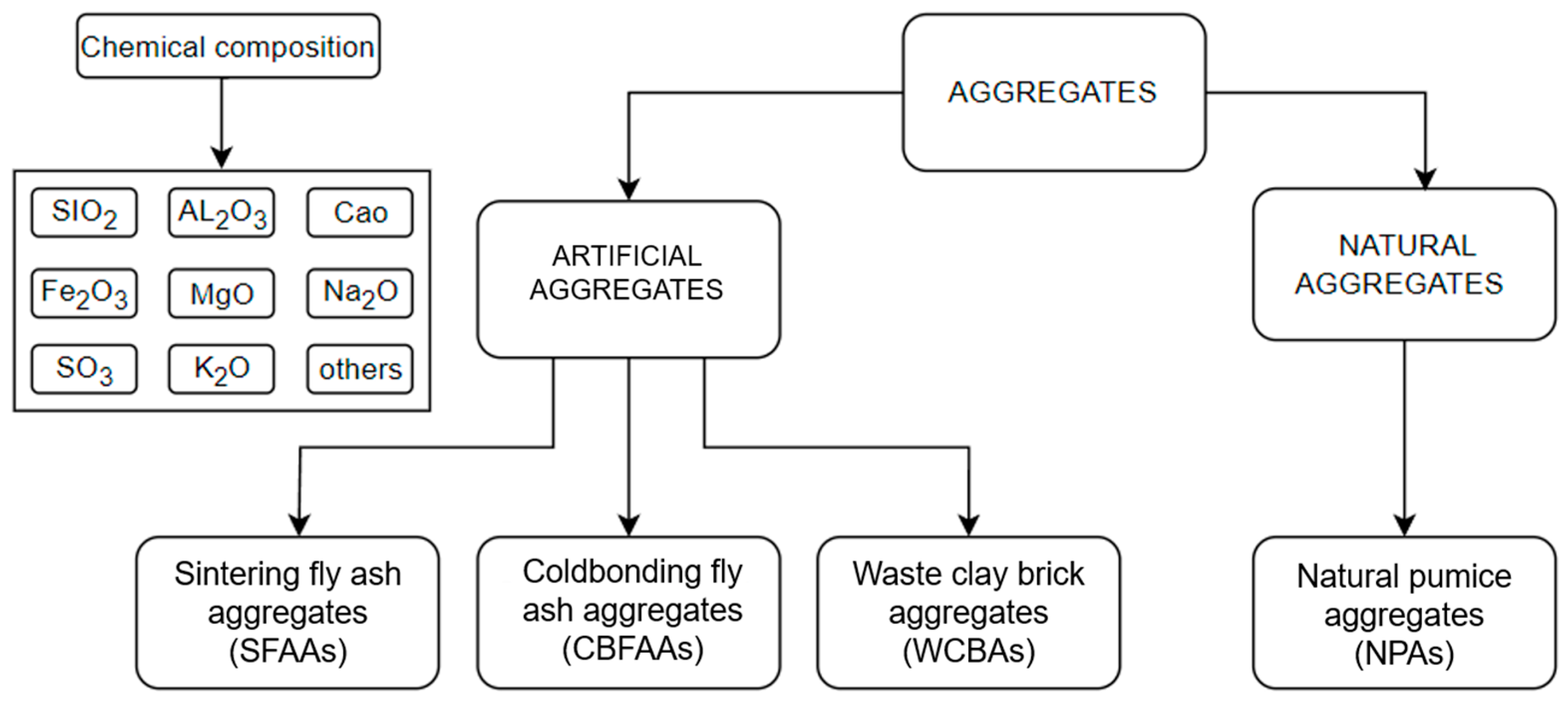
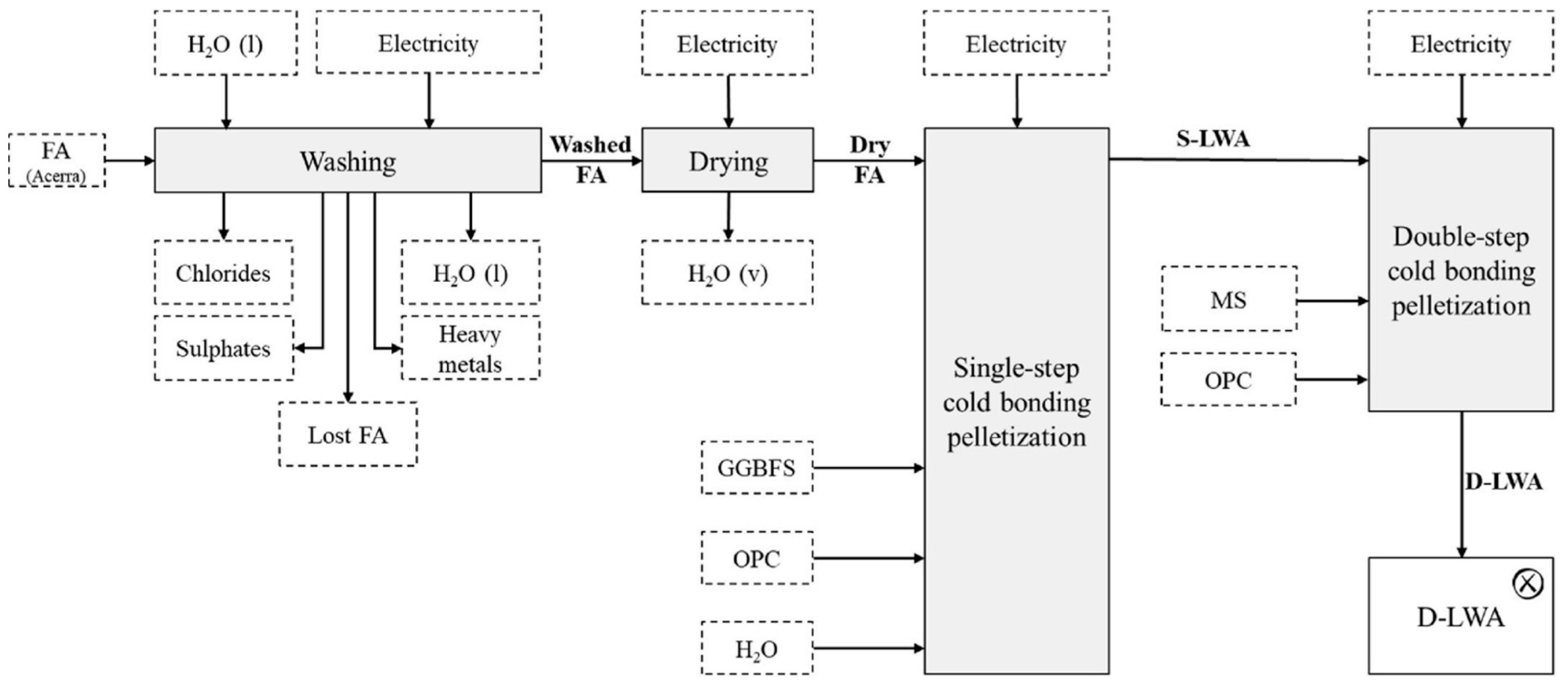
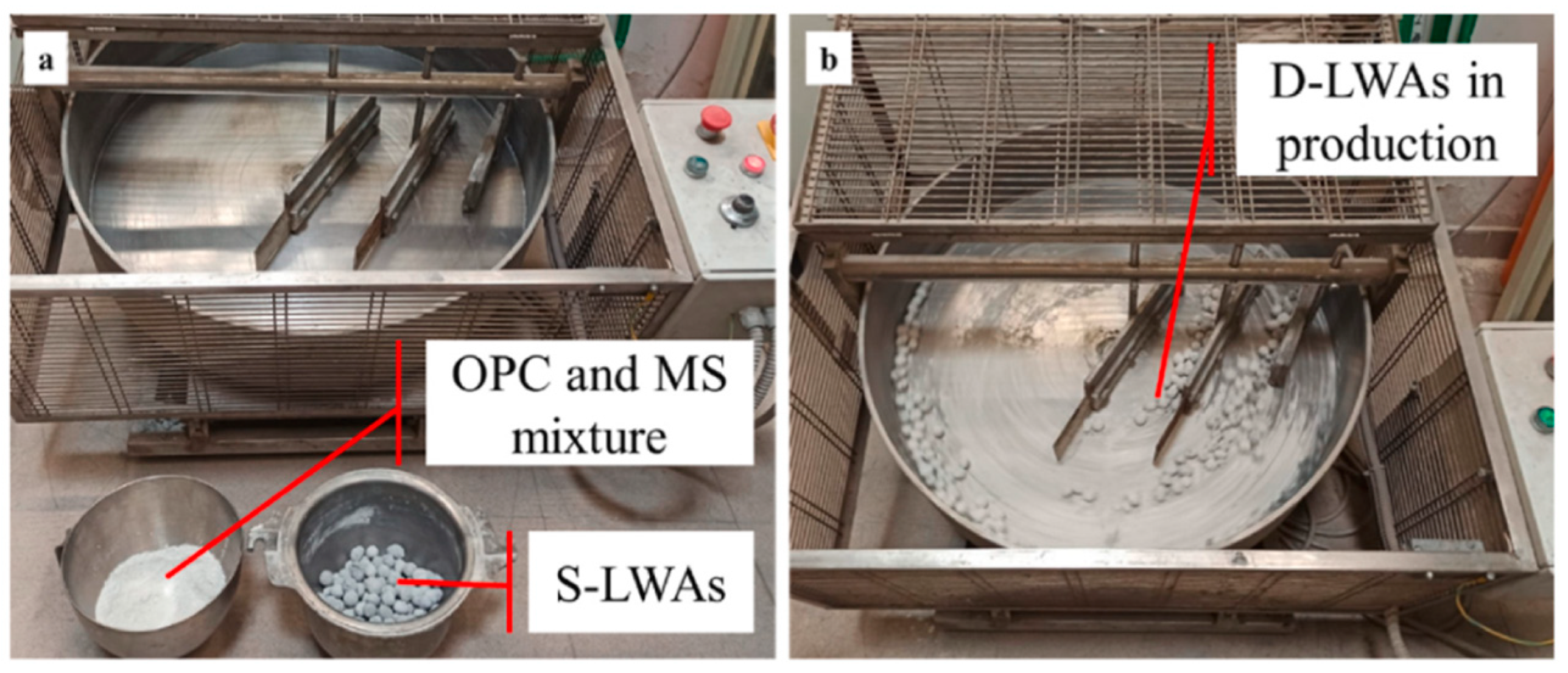
| Material | Chemical Composition—Major Components | Origin | Bulk Density (kg/m³) |
|---|---|---|---|
| Expanded perlite | SiO2—74.8%, Al2O3—13.1%, CaO—1.3% | Thermal expansion | 30–150 |
| Sintered fly ash | SiO2—58.69%, Al2O3—25.10%, Fe2O3—5.80% | Pelletizing fly ash collected from coal combustion | 645–755 |
| Expanded polystyrene | (C6H6CH2CH2)n | Polystyrene plastic beads filled with pentane | 11–34 |
| Palm oil clinker | SiO2—59.63%, K2O—11.66%, CaO—8.16% | By-product of oil palm shell and fiber incineration | 1440–1850 |
| Expanded glass | SiO2—59.63%, CaO—8.05%, MgO—2.78% | Unrecyclable waste glass treated with MgCO3 and CaCO3 at 900–1300 °C | 400 |
| Expanded shale | SiO2—54.59%, Al2O3—18.49%, Fe2O3—9.54% | Angular-shaped clay sedimentary rock exposed to 1100–1300 °C | 500–800 |
| Diatomite | SiO2—78.24%, Al2O3—0.55%, Fe2O3—1.12% | Sedimentary rock formed by deposits of silica shells of aquatic algae | 500–928 |
| Scoria | SiO2—52.53%, Al2O3—15.49%, Fe2O3—11% | Porous reddish-brown to black rock from molten magma | 1160 |
| Expanded vermiculite | SiO2—25%, Al2O3—10%, Fe2O3—35%, MgO—40% | Plate-like material formed from mica disintegration, heated to 650–1000 °C | 64 |
| Pumice | SiO2—69.78%, Al2O3—11.16%, Fe2O3—2.11% | Microporous natural material of volcanic origin | 835 |
| Coal bottom ash | SiO2—54.5%, Al2O3—15.4%, Fe2O3—11.16% | By-products collected from the bottom of thermal power plants | 641–1440 |
| Light expanded clay | SiO2—65.28%, Al2O3—15.23%, Fe2O3—9.14% | Bloated particles of burnt clay | 250–510 |
| Aspect | Details | Ref. |
|---|---|---|
| Raw material sourcing | LWAs are often produced from natural resources like clay, shale, or slate, which are abundant but require mining, impacting land use and ecosystems. | [80] |
| Energy consumption | The production process involves high-temperature kilns, consuming significant energy and contributing to greenhouse gas emissions. | [81] |
| Waste utilization | LWAs can be made from industrial by-products such as fly ash or slag, promoting recycling and reducing waste sent to landfills. | [82] |
| Emissions | High-temperature processes can emit CO2 and other pollutants. Advanced technologies can mitigate these emissions, but their adoption varies. | [75] |
| Resource efficiency | LWAs are lightweight, reducing the load on structures and potentially decreasing the amount of material needed for certain applications. | [48] |
| Thermal insulation | LWAs have good insulating properties, enhancing the energy efficiency of buildings and reducing heating and cooling demands. | [83] |
| Durability | High durability and long lifespan mean fewer replacements and lower resource consumption over time. | [84] |
| Transportation impact | Being lighter, LWAs reduce transportation energy compared to heavier materials. However, the distance from production sites to usage points can still be a factor. | [85] |
| Recyclability | End-of-life recycling is feasible, although currently, it may not be widespread. Recycled LWAs can be used in new construction projects. | [86] |
| Water use | The production process requires water, impacting local water resources. Water recycling systems in plants can alleviate this. | [87] |
| Biodiversity impact | Mining operations for raw materials can affect local flora and fauna. Mitigation strategies include habitat restoration post-mining. | [88] |
| Type of Aggregate | GHG Emissions | Land/Resource Impacts | Air/Water Pollution |
|---|---|---|---|
| Natural aggregates | High (due to extraction/transport) | Habitat loss, soil erosion, and deforestation | Dust emissions and water pollution [90] |
| Artificial recycled aggregates | Low to Moderate (lower production emissions) | Landfill diversion and resource conservation | Dust and noise (minimal compared to natural aggregates) [91] |
| Manufactured aggregates | Moderate (depending on processing) | Waste utilization and resource efficiency | Contaminants from industrial by-products [92] |
| Lightweight aggregates (natural) | High (energy-intensive production) | Impacts of mining raw materials | Kiln emissions (NOx and SOx) and dust [93] |
| Marine aggregates | High (due to dredging/transport) | Marine habitat destruction and coastal erosion | Sediment plumes and water pollution [94] |
| Mixture Name | Single-Step Cold Bonding Palletization | Double-Step Cold Bonding Palletization | |||
|---|---|---|---|---|---|
| PC (%) | GGBFS (%) | MSWI-FA (%) | (%) | MS(%) | |
| D-LWA A | 5 | 15 | 0 | 0 | 70 |
| D-LWA B | 10 | 0 | 80 | 0 | 70 |
| D-LWA C | 15 | 5 | 0 | 0 | 70 |
Disclaimer/Publisher’s Note: The statements, opinions and data contained in all publications are solely those of the individual author(s) and contributor(s) and not of MDPI and/or the editor(s). MDPI and/or the editor(s) disclaim responsibility for any injury to people or property resulting from any ideas, methods, instructions or products referred to in the content. |
© 2024 by the authors. Licensee MDPI, Basel, Switzerland. This article is an open access article distributed under the terms and conditions of the Creative Commons Attribution (CC BY) license (https://creativecommons.org/licenses/by/4.0/).
Share and Cite
Singh, N.; Raza, J.; Colangelo, F.; Farina, I. Advancements in Lightweight Artificial Aggregates: Typologies, Compositions, Applications, and Prospects for the Future. Sustainability 2024, 16, 9329. https://doi.org/10.3390/su16219329
Singh N, Raza J, Colangelo F, Farina I. Advancements in Lightweight Artificial Aggregates: Typologies, Compositions, Applications, and Prospects for the Future. Sustainability. 2024; 16(21):9329. https://doi.org/10.3390/su16219329
Chicago/Turabian StyleSingh, Narinder, Jehangeer Raza, Francesco Colangelo, and Ilenia Farina. 2024. "Advancements in Lightweight Artificial Aggregates: Typologies, Compositions, Applications, and Prospects for the Future" Sustainability 16, no. 21: 9329. https://doi.org/10.3390/su16219329
APA StyleSingh, N., Raza, J., Colangelo, F., & Farina, I. (2024). Advancements in Lightweight Artificial Aggregates: Typologies, Compositions, Applications, and Prospects for the Future. Sustainability, 16(21), 9329. https://doi.org/10.3390/su16219329









